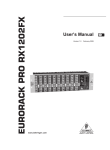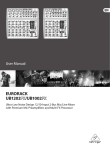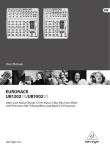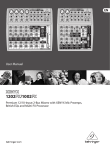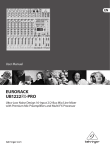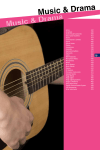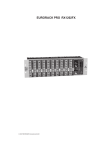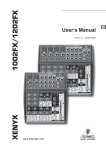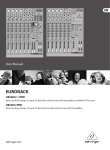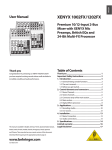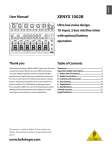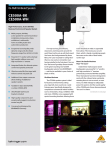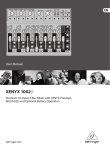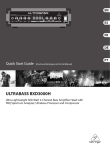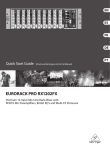Download Behringer RX1202FX User's Manual
Transcript
User Manual EURORACK PRO RX1202FX Premium 12-Input Mic/Line Rack Mixer with XENYX Mic Preamplifiers, British EQ's and Multi-FX Processor 2 EURORACK PRO RX1202FX User Manual Table of Contents Thank you........................................................................ 2 Important Safety Instructions....................................... 3 Legal Disclaimer.............................................................. 3 Limited warranty............................................................. 3 1. Introduction................................................................ 4 1.1 General mixing console functions ................................ 4 1.2 The user’s manual................................................................ 5 1.3 Before you get started....................................................... 5 2. Control Elements and Connectors ........................... 5 2.1 Mono channels..................................................................... 5 2.2 Stereo channels.................................................................... 6 2.3 Connector array of the main section............................ 7 2.4 Main section.......................................................................... 8 2.5 Digital effects processor................................................... 9 2.6 Voltage supply, phantom power supply and fuse........................................................................................... 9 3. Applications.............................................................. 10 3.1 Recording studio................................................................ 10 3.2 Live sound............................................................................ 11 4. Installation................................................................ 12 4.1 Mains connection.............................................................. 12 4.2 Audio connections............................................................ 12 5. Specifications............................................................ 13 Thank you Congratulations! In purchasing our EURORACK PRO RX1202FX you have acquired a mixing console whose small size belies its incredible versatility and audio performance. 3 EURORACK PRO RX1202FX User Manual Important Safety Instructions Terminals marked with this symbol carry electrical current of sufficient magnitude to constitute risk of electric shock. Use only high-quality professional speaker cables with ¼" TS or twist-locking plugs pre-installed. All other installation or modification should be performed only by qualified personnel. This symbol, wherever it appears, alerts you to the presence of uninsulated dangerous voltage inside the enclosure - voltage that may be sufficient to constitute a risk of shock. This symbol, wherever it appears, alerts you to important operating and maintenance instructions in the accompanying literature. Please read the manual. Caution To reduce the risk of electric shock, do not remove the top cover (or the rear section). No user serviceable parts inside. Refer servicing to qualified personnel. Caution To reduce the risk of fire or electric shock, do not expose this appliance to rain and moisture. The apparatus shall not be exposed to dripping or splashing liquids and no objects filled with liquids, such as vases, shall be placed on the apparatus. 9. Do not defeat the safety purpose of the polarized or grounding-type plug. A polarized plug has two blades with one wider than the other. A grounding-type plug has two blades and a third grounding prong. The wide blade or the third prong are provided for your safety. If the provided plug does not fit into your outlet, consult an electrician for replacement of the obsolete outlet. 10. Protect the power cord from being walked on or pinched particularly at plugs, convenience receptacles, and the point where they exit from the apparatus. 11. Use only attachments/accessories specified by the manufacturer. 12. Use only with the cart, stand, tripod, bracket, or table specified by the manufacturer, or sold with the apparatus. When a cart is used, use caution when moving the cart/apparatus combination to avoid injury from tip-over. 13. Unplug this apparatus during lightning storms or when unused for long periods of time. 14. Refer all servicing to qualified service personnel. Servicing is required when the apparatus has been damaged in any way, such as power supply cord or plug is damaged, liquid has been spilled or objects have fallen into the apparatus, the apparatus has been exposed to rain or moisture, does not operate normally, or has been dropped. 15. The apparatus shall be connected to a MAINS socket outlet with a protective earthing connection. 16. Where the MAINS plug or an appliance coupler is used as the disconnect device, the disconnect device shall remain readily operable. Caution These service instructions are for use by qualified service personnel only. To reduce the risk of electric shock do not perform any servicing other than that contained in the operation instructions. Repairs have to be performed by qualified service personnel. 1. Read these instructions. 2. Keep these instructions. 3. Heed all warnings. 4. Follow all instructions. 5. Do not use this apparatus near water. 6. Clean only with dry cloth. 7. Do not block any ventilation openings. Install in accordance with the manufacturer’s instructions. 8. Do not install near any heat sources such as radiators, heat registers, stoves, or other apparatus (including amplifiers) that produce heat. LEGAL DISCLAIMER TECHNICAL SPECIFICATIONS AND APPEARANCES ARE SUBJECT TO CHANGE WITHOUT NOTICE AND ACCURACY IS NOT GUARANTEED. BEHRINGER, KLARK TEKNIK, MIDAS, BUGERA, AND TURBOSOUND ARE PART OF THE MUSIC GROUP (MUSIC-GROUP.COM). ALL TRADEMARKS ARE THE PROPERTY OF THEIR RESPECTIVE OWNERS. MUSIC GROUP ACCEPTS NO LIABILITY FOR ANY LOSS WHICH MAY BE SUFFERED BY ANY PERSON WHO RELIES EITHER WHOLLY OR IN PART UPON ANY DESCRIPTION, PHOTOGRAPH OR STATEMENT CONTAINED HEREIN. COLORS AND SPECIFICATIONS MAY VARY FROM ACTUAL PRODUCT. MUSIC GROUP PRODUCTS ARE SOLD THROUGH AUTHORIZED FULLFILLERS AND RESELLERS ONLY. FULLFILLERS AND RESELLERS ARE NOT AGENTS OF MUSIC GROUP AND HAVE ABSOLUTELY NO AUTHORITY TO BIND MUSIC GROUP BY ANY EXPRESS OR IMPLIED UNDERTAKING OR REPRESENTATION. THIS MANUAL IS COPYRIGHTED. NO PART OF THIS MANUAL MAY BE REPRODUCED OR TRANSMITTED IN ANY FORM OR BY ANY MEANS, ELECTRONIC OR MECHANICAL, INCLUDING PHOTOCOPYING AND RECORDING OF ANY KIND, FOR ANY PURPOSE, WITHOUT THE EXPRESS WRITTEN PERMISSION OF MUSIC GROUP IP LTD. ALL RIGHTS RESERVED. © 2013 MUSIC Group IP Ltd. Trident Chambers, Wickhams Cay, P.O. Box 146, Road Town, Tortola, British Virgin Islands LIMITED WARRANTY For the applicable warranty terms and conditions and additional information regarding MUSIC Group’s Limited Warranty, please see complete details online at www.music-group.com/warranty. 4 EURORACK PRO RX1202FX User Manual 1. Introduction 1.1 General mixing console functions With 8 phantom-powered microphone inputs as well as 4 high-headroom line inputs, the RX1202FX comprises a total of 12 channels. All channels come with 60-mm faders and the extremely musical 2-band EQ, the clip LEDs, as well as the 2 aux sends enable an uncompromising functionality of the console. An integrated power supply guarantees optimal flexibility through worldwide independence of any mains connection. Additionally, it offers an absolutely noiseless audio signal as well as an outstanding transient response by minimal power consumption. With first-class “Invisible“ Mic Preamps, the ultra-low noise circuitry, the 24-bit effects processor as well as the separate control room, headphones and CD/tape outputs, the RX1202FX has all the features that also distinguish our UB mixers. A mixing console fulfils three main functions: As sub-mixer, monitor mixer or as line mixer for audio/video installations, the RX1202FX is the first choice for demanding fixed installations and mobile use. IMP “INVISIBLE” MIC PREAMP The microphone channels are fitted with BEHRINGER’s premium quality IMP invisible mic preamps that boast the following features: • 130 dB dynamic range for an incredible amount of headroom • A bandwidth ranging from below 10 Hz to over 200 kHz for crystal-clear reproduction of even the finest nuances • The extremely low-noise and distortion-free circuitry guarantees absolutely natural and transparent signal reproduction • They are perfectly matched to every conceivable microphone with up to 60 dB gain and +48 volt phantom power supply • They enable full utilization of the greatly extended dynamic range of your 24-bit/192 kHz HD recorder, thereby maintaining optimal audio quality. MULTI-EFFECTS PROCESSOR In addition, the RX1202FX offers an effects processor equipped with 24-bit A/D and D/A converters. The FX processor puts at your disposal 100 presets with first-class room simulations, delay and modulation effects, and many multi-effects in outstanding audio quality. !! Caution! ◊ We would like to inform you that high volume can damage your hearing and/or the headphones or loudspeakers. Before turning on the device, please move the MAIN MIX fader of the main section all the way down. Always take care to keep an appropriate volume level. • Signal processing: Preamplification Microphones convert sound waves into voltage that has to be amplified several-fold; then, this voltage is turned into sound that is reproduced in a loudspeaker. Because microphone capsules are very delicate in their construction, output voltage is very low and therefore susceptible to interference. Therefore, mic signal voltage is amplified directly at the mixer input to a higher signal level that is less prone to interference. This higher, interference-safe signal level has to be achieved through amplification using an amplifier of the highest quality in order to amplify the signal and add as little noise to it as possible. The IMP “Invisible” Mic Preamp performs this role beautifully, leaving no traces of noise or sound coloration. Interference that could take place at the preamplification level could affect signal quality and purity, and would then be passed on to all other devices, resulting in inaccurate sounding program during recording or playback. Level-setting Signals fed into the mixer using a DI box (Direct Injection) or the output of a sound card or a keyboard, often have to be adjusted to the operating level of your mixing console. Frequency response correction Using the equalizers found in each channel strip, you can simply, quickly and effectively adjust the way a signal sounds. • Signal distribution: Individual, processed signals from the channel strips are compiled on busses and are fed into the main section for further processing. Connections for recording equipment, power amplifiers, headphones as well as CD/tape connectors are available here. The mix is sent to the internal FX processors or external effects processors via aux sends and returns. Similarly, a mix can be created for the musicians on the stage (monitor mix). • Mix: All other mixing console functions fall under this vital category. Creating a mix means primarily adjusting the volume levels of individual instruments and voices to one another as well as giving them the appropriate weight within the overall frequency spectrum. Likewise, you’ll have to sensibly spread individual voices across the stereo image of a signal. At the end of this process, adjusting the level of the entire mix to other equipment in the signal path is required (e. g. recorder/crossover/amplifier). The interface of BEHRINGER mixing consoles is optimized for these tasks, enabling you to easily keep track of the signal path. 5 EURORACK PRO RX1202FX User Manual 1.2 The user’s manual 1.3.3 Online registration The user’s manual is designed to give you both an overview of the controls, as well as detailed information on how to use them. In order to help you understand the links between the controls, we have arranged them in groups according to their function. If you need to know more about specific issues, please visit our website at http://behringer.com. Additional information and explanations about various music industry/audio technology terminology can be found on individual product pages as well as in the glossary area of behringer.com. Please register your new BEHRINGER equipment right after your purchase by visiting http://behringer.com and read the terms and conditions of our warranty carefully. ◊ The block diagram supplied with the mixing console gives you an overview of the connections between the inputs and outputs, as well as the associated switches and controls. For the moment, just try and trace the signal path from the microphone input to the FX SEND connector. Don’t be put off by the huge range of possibilities; it’s easier than you think! If you look at the overview of the controls at the same time, you’ll be able to quickly familiarize yourself with your mixing console and you’ll soon be making the most of all its many possibilities. Should your BEHRINGER product malfunction, it is our intention to have it repaired as quickly as possible. To arrange for warranty service, please contact the BEHRINGER retailer from whom the equipment was purchased. Should your BEHRINGER dealer not be located in your vicinity, you may directly contact one of our subsidiaries. Corresponding contact information is included in the original equipment packaging (Global Contact Information/European Contact Information). Should your country not be listed, please contact the distributor nearest you. A list of distributors can be found in the support area of our website (http://behringer.com). Registering your purchase and equipment with us helps us process your repair claims more quickly and efficiently. Thank you for your cooperation! 1.3 Before you get started 2. Control Elements and Connectors 1.3.1 Shipment This chapter describes the various control elements of your mixing console. All controls, switches and connectors will be discussed in detail. Your mixing console was carefully packed in the factory to guarantee safe transport. Nevertheless, we recommend that you carefully examine the packaging and its contents for any signs of physical damage that may have occurred during transit. 2.1 Mono channels ◊ If the unit is damaged, please do NOT return it to us, but notify your dealer and the shipping company immediately, otherwise claims for damage or replacement may not be granted. ◊ To assure optimal protection of your EURORACK during use or transport, we recommend utilizing a carrying case. ◊ Please always use the original packaging to avoid damage due to storage or shipping. ◊ Never let unsupervised children play with the EURORACK or with its packaging. ◊ Please dispose of all packaging materials in an environmentally-friendly fashion. 1.3.2 Initial operation Be sure that there is enough space around the unit for cooling purposes and to avoid overheating please do not place your mixing console on high-temperature equipment such as radiators or power amps. ◊ Never connect the EURORACK to the power supply unit when the latter is connected to the mains! First connect the power supply unit to the console, then connect the power supply unit to the mains. ◊ Please make sure that all units have a proper ground connection. For your own safety, never remove or disable the ground conductor from the unit or on the AC power cord. The unit should always be connected to a mains socket outlet with a protective earthing connection. ◊ When installing the product, ensure the appliance coupler or power cord is easily accessible for disconnecting the unit from mains. Fig. 2.1: Connectors and controls on the mono channels MIC Each mono input channel offers a balanced microphone input via the XLR connector and also features a switchable +48 V phantom power supply for condenser microphones. ◊ Please mute your playback system before you activate the phantom power supply to prevent switch-on thumps being directed to your loudspeakers. Please also note the instructions in chapter 2.4 “Main section”. 6 EURORACK PRO RX1202FX User Manual LINE IN Each mono input also features a balanced line input on a 1/4" connector. Unbalanced devices (mono connectors) can also be connected to these inputs. ◊ Please remember that you can only use either the microphone or the line input of a channel at any one time. You can never use both simultaneously! The MON path—as the name already implies—is meant to be used as monitor signal path. For this application, it is important that the controller works as pre-fader, which means it does not rely on the fader position. For this reason the AUX send path is unsuitable for the connection to effects devices. By using the MON controller, you can produce a mono mix of individual signals that can be routed over the MON plug, located on the backside, to a headphones amplifier (e.g. MINIAMP AMP800) or a power amplifier for monitoring. INSERT PAN The INSERT connector is input and output at the same time. This allows you to insert external signal processors (compressors, gate, etc.) in the channel. The signal retrieval occurs after the TRIM and is practically a diversion of the signal. The input signal of the connected signal processor is diverted, processed and led back to the channel for further processing. The PAN control determines the position of the channel signal within the stereo image. This control features a constant-power characteristic, which means the signal is always maintained at a constant level, irrespective of position in the stereo panorama. TRIM Use the TRIM control to adjust the input gain. This control should always be turned fully counterclockwise whenever you connect or disconnect a signal source to one of the inputs. The scale has 2 different value ranges: the first value range (+10 to +60 dB) refers to the MIC input and shows the amplification for the signals fed in there. The second value range (+10 to -40 dBu) refers to the line input and shows its sensitivity. The settings for equipment with standard line-level signals (-10 dBV or +4 dBu) look like this: While the TRIM control is turned all the way down, connect your equipment. Set the TRIM control to the external devices’ standard output level. If that unit has an output signal level display, it should show 0 dB during signal peaks. For +4 dBu, turn up TRIM slightly, for -10 dBV a bit more. Tweaking is done using the CLIP LED. CLIP The CLIP LEDs of the mono channels illuminate when the input signal is driven too high, which could cause distortion. If this happens, use the TRIM control to reduce the preamp level until the LED does not light anymore. Channel fader The channel fader determines the level of the channel signal in the Main Mix. ◊ Caution: The channel fader needs to be open so that the effects processor receives a signal from this channel because the FX bus to the effects processor is switched to post-fader! 2.2 Stereo channels HIGH/LOW All mono input channels include a 3-band equalizer. All bands provide boost or cut of up to 15 dB. In the central position, the equalizer is inactive. The upper (HIGH) and the lower band (LOW) are shelving filters that increase or decrease all frequencies above or below their cut-off frequency. The cut-off frequencies of the upper and lower band are 12 kHz and 80 Hz respectively. MON/FX FX send buses (or AUX send buses) enable you to extract signals from one or more channels and collect these on a bus. You can retrieve the signal at the send connector to direct it to an external effects device, for example. The AUX return input is used as the return path. The send buses of the RX1202FX are mono buses. As the name suggests, the FX sends of the EURORACK mixing consoles are intended to drive effects devices (reverb, delay, etc.) and are therefore configured post-fader. This means that the mix between dry signal and effect remains at the level determined by the channel’s aux send, irrespective of the channel fader setting. If this were not the case, the effects signal of the channel would remain audible even when the fader is lowered to zero. In the RX1202FX, the FX send is routed directly to the built-in effects processor. To make sure that the effects processor receives an input signal, you shouldn’t turn this control all the way to the left (-∞). Fig. 2.2: Connectors and controls on the stereo channels LINE IN Each stereo channel has two balanced line level inputs on 1/4" connectors for left and right channels. If only the connector marked “L” (left) is used, the channel operates in mono. The stereo channels are designed to handle typical line level signals. Both inputs will also accept unbalanced connectors. 7 EURORACK PRO RX1202FX User Manual TRIM MAIN OUT The controller works the same as the one for the mono channels. However, the level control range is limited from +20 to -20 dBu because the stereo channels only process line signals. The MAIN OUT connectors are balanced and laid out as XLR connectors. Here the summed signal of the main mix has a level of 0 dBu. According to the way you want to use the mixer and which equipment you have, following devices can be connected: HIGH/LOW The stereo-channel equalizer features 2 bands like the one used for the mono channels. MON/FX The MON/FX buses of the stereo channels work like those of the mono channels. Since both paths are mono, the signal of a stereo channel is initially mixed to a summed mono signal before reaching the MON/FX bus. BAL The BAL(ANCE) control determines the levels of left and right input signals relative to each other before both signals are then routed to the main stereo mix bus. If a channel is operated in mono via the left line input, this control has the same function as the PAN control used in the mono channels. CLIP The CLIP LEDs of the stereo channels light up when the input signal’s level is too high. In this case, reduce the preamplification with the TRIM controller until the LED goes out. Channel fader As with the mono channels, the channel fader determines the level of the channel strip for the stereo channels in the main mix. 2.3 Connector array of the main section Live PA systems: A stereo dynamics processor (optional), stereo equalizer (optional) and the stereo power amplifier for full-range loudspeakers with passive crossovers. If you wish to use multi-way loudspeaker systems without an integrated crossover, you have to use an active crossover and several power amplifiers. Often, limiters are already built into active crossovers (e.g. BEHRINGER SUPER-X PRO CX2310 and ULTRADRIVE PRO DCX2496). Active crossovers are implemented directly before the power amplifier, and they divide the frequency range into several segments that are first amplified in the amplifiers and then passed on to the corresponding loudspeakers. Recording: For mastering, using a stereo compressor such as the COMPOSER PRO-XL MDX2600 can be recommended. Use it to custom-tailor the dynamic characteristics of your signal to the dynamic range of the recording equipment you are using. The signal is in this case passed on from the compressor into the recorder. CTRL OUT The CTRL OUT connectors are used for controlling the summed signal (effects mix and main mix) as well as for individual signals over studio monitor speakers. By using the PHONES/CONTROL ROOM controller in the main section, you can control the level of both outputs. CD/TAPE IN The CD/TAPE INs are used to bring an external signal source (e.g. CD player, tape deck, etc.) into the console. They can also be used as a standard stereo line input, so the output of a second EURORACK or BEHRINGER ULTRALINK PRO MX882 can be connected. Alternatively, the line or tape output of a hi-fi amplifier with source selection switch could also be hooked up here, allowing you to easily listen to additional sources (e.g. cassette recorder, minidisk player, sound card etc.). CD/TAPE OUT These connections are laid out as RCA connectors and are wired parallel to MAIN OUT. Connect the inputs of a computer sound card or a recorder here. The output signal level is set up using the highly accurate MAIN MIX fader. AUX SENDS Fig.2.3: Connectors of the main section The FX connector routes the signal, which you have extracted from the individual channels by using the FX controller; the MON plug does the same to the signal that has been extracted by using the MON controller. Connect the input of an external effects processor to the FX plug, with which you want to modify the signal sum of the FX bus. Then, route the effects signal back to the mixer over the AUX RETURN connectors. With the MON outputs, you can connect an amplifier/headphones amplifier for the musicians to monitor. 8 EURORACK PRO RX1202FX User Manual ◊ When the connected effects device does not receive an input signal, none of the FX controllers are probably turned up, which also applies to the integrated effects -processor. ◊ Adjust your external effects processor to 100% wet (effects signal only), because the effects signal is added to the main mix along with the “dry” channel signals. AUX RETURN You can connect the outputs of an external effects device to the AUX RETURN connectors. In this case, the effects signal is routed directly to the main mix bus and is then mixed with the “dry” signal. It is also possible to route the effects signal as mono by using the L connector. ◊ You can also use the AUX RETURN connectors as additional stereo input channels, although, in this case, there are no possibilities to control the level, timbre and panning. 2.4 Main section POWER The blue POWER LED indicates that the console is powered on. LEVEL INDICATOR The 4-segment display accurately displays the relevant signal level. Level Control: To level the signal, you should set the channel fader of the input channels to 0 dB and raise the input amplification with the TRIM controller to the extent that a level of maximal 0 dB is displayed. When recording to digital recorders, the recorder’s peak meter should not go into overload. While analog recorders can be overloaded to some extent, creating only a certain amount of distortion, digital recorders distort quickly when overloaded. In addition, digital distortion is not only undesirable, but also renders your recording completely useless. When recording to an analog device, the VU meters of the recording machine should reach approx. +3 dB with low-frequency signals (e.g. kick drum). Due to their inertia VU meters tend to display too low a signal level at frequencies above 1 kHz. This is why, for example, a Hi-Hat should only be driven as far as -10 dB. Snare drums should be driven to approx. 0 dB. ◊ The CLIP LEDs of your EURORACK display the level virtually independent of frequency. A recording level of 0 dB is recommended for all signal types. MAIN MIX Use the MAIN MIX fader to adjust the volume of the main out. PHONES The connector is used to connect a pair of headphones. The volume level is changed with the PHONES/CONTROL ROOM controller. PHONES/CONTROL ROOM Fig. 2.4: Control elements of the main section +48 V The red “+48 V”-LED lights up when the phantom power supply is switched on. Phantom powering is necessary to use condenser microphones and is activated with the PHANTOM ON switch found on the backside. ◊ Connect microphones before you switch on the phantom power supply. Please do not connect microphones to the mixer (or the stagebox/ wallbox) while the phantom power supply is switched on. In addition, the monitor/PA loudspeakers should be muted before you activate the phantom power supply. After switching on, wait approx. one minute to allow for system stabilization. ◊ Caution! You must never use unbalanced XLR connectors (PIN 1 and 3 connected) on the MIC input connectors if you want to use the phantom power supply. Use the PHONES/CONTROL ROOM control to adjust the signal level of the CTRL OUT and PHONES outputs. FX SOLO If you want to only listen to the effects signal with your headphones or monitor speakers, then press the FX SOLO switch. The signal of the effects device can then be heard individually; the main mix or CD/tape signal is inaudible at the PHONES and CTRL OUT outputs. CD/TAPE TO CTRL Press the CD/TAPE TO CTRL switch if you want to monitor the CD/TAPE IN via the CTRL OUT and PHONES outputs. A typical studio application of this function is recording music into a digital audio workstation (DAW) with simultaneous reproduction (see ch. 3.1). ◊ When you are recording a signal over the CD/TAPE OUT and simultaneously want to monitor over the CD/TAPE IN, the CD/TAPE TO MIX switch is not allowed to be pressed. Otherwise a feedback loop would occur because this signal would be sent over the Main Mix back to the CD/TAPE OUT. In case of such an application, you should send the CD/TAPE signal to the monitor speakers or headphones by using the CD/TAPE TO CTRL switch. In contrast to the main mix, this signal is not sent to the CD/TAPE OUT. 9 EURORACK PRO RX1202FX User Manual CD/TAPE TO MIX When the CD/TAPE TO MIX switch is pressed, the CD/tape input is assigned to the main mix providing an additional input for tape machines, MIDI instruments or other signal sources that do not require any processing. 2.5 Digital effects processor 2.6 Voltage supply, phantom power supply and fuse FUSE HOLDER/IEC MAINS RECEPTACLE The mains connection is made via a cable with an IEC mains connector and meets the required safety standards. An appropriate mains cable is supplied with the equipment. Blown fuses must only be replaced by fuses of the same type and rating. Fig. 2.6: Voltage supply and fuse Fig. 2.5: Effects section POWER switch 100 FIRST-CLASS EFFECTS Use the POWER switch to turn on the mixing console. The POWER switch should always be in the “Off” position when you are about to connect your unit to the mains. The EURORACK RX1202FX features a built-in digital stereo effects processor. This effects processor offers a large number of standard effects such as Hall, Chorus, Flanger, Delay and various combination effects. Using the FX control, you can feed signals into the effects processor. The integrated effects module has the advantage of requiring no wiring. This way, the danger of creating ground loops or uneven signal levels is eliminated at the outset, completely simplifying the handling. SIG and CLIP LED The SIG LED on the effects module shows the presence of a signal whose level is high enough. This LED should always be on. However, make sure that the CLIP LED lights up only sporadically. If it is lit constantly, you are overdriving the effects processor, which leads to unpleasant distortion. If this occurs, turn the FX controls down somewhat. PROGRAM The PROGRAM control has two functions: by turning the PROGRAM control, you dial the number of an effect. The number of the preset you just dialed up blinks in the display. To confirm your selection, press the PROGRAM control; the blinking stops. FX TO MAIN By using the FX TO MAIN controller, the effects signal is sent to the main mix. No effects signal is to be heard in the summed signal of the mixer when the controller is positioned entirely to the left. Choose this position if you want to use an external effects device for the FX output. An overview of all the multieffect processor’s presets are to be found in the appendix. To disconnect the unit from the mains, pull out the main cord plug. When installing the product, ensure that the plug is easily accessible. If mounting in a rack, ensure that the mains can be easily disconnected by a plug pull or by an all-pole disconnect switch on or near the rack. ◊ Attention: The POWER switch does not fully disconnect the unit from the mains. Unplug the power cord completely when the unit is not used for prolonged periods of time. PHANTOM switch The PHANTOM switch activates the phantom power (necessary to operate condenser microphones) on the XLR sockets of the mono channels. The red +48 V LED illuminates when phantom power is on. As a rule, dynamic microphones can still be used with phantom power, provided that they are wired in a balanced configuration. In case of doubt, contact the microphone manufacturer! ◊ Connect microphones before you switch on the phantom power supply. Please do not connect microphones to the mixer (or the stagebox/ wallbox) while the phantom power supply is switched on. In addition, the monitor/PA loud-speakers should be muted before you activate the phantom power supply. After switching on, wait approx. one minute to allow for system stabilization. ◊ Caution! Please also note the information given in chapter 4.2 “Audio connections”. SERIAL NUMBER Please note the important information on the serial number given in chapter 1.3.3. 10 EURORACK PRO RX1202FX User Manual 3. Applications 3.1 Recording studio TRUTH B200A Keyboard MIDI sound module HPS3000 B-2 Pro MD Recorder HPS3000 V-Amp 3 Laptop F-Control FCA202 Mini Amp Amp 800 Electric Guitar Fig. 3.1: The RX1202FX in a recording studio Even though most of the tasks in a studio can nowadays be accomplished using a computer, a mixing console remains an unavoidable piece of equipment that lets you effectively manage audio inputs and outputs: microphone signals need to be pre-amplified prior to being recorded, and the quality of microphone sound is often worked on; recording and playback signals must be routed to the appropriate connectors or integrated into the mix; the volume of headphones and studio monitors needs to be adjusted, and so on. The well-equipped main section of the RX1202FX is extremely useful in this case. Cabling: Connect your sound sources to the mic or line inputs of the mixer. Join your master machine (DAT/MD recorder) to the main outputs. Your monitor speaker is connected to the CTRL OUT connector, the headphones to the PHONES output. Now attach the CD/TAPE outputs with the inputs of the sound card of your Digital Audio Workstation (DAW). Hook up the outputs of the computer’s soundcard to the CD/TAPE inputs. Connect a headphone amplifier to the MON connector to be able to provide performing musicians with a monitoring signal. Record and playback: The recording signal is preamplified in a mixer’s channel, processed with the EQ and routed back to the main bus. Determine the recording level with the LEVEL fader. The entire level to the computer is adjusted with the MAIN MIX fader. To ensure that the signal is really being recorded, you should not listen in to the main mix signal (i.e. the output signal of the console, prior to recording) of the phones or control room bus. Instead, listen in to the returned signal of the soundcard that is connected to the CD/TAPE inputs, in which case you have a kind of read-after-write control. In this case, press the CD/TAPE TO CTRL switch and adjust the volume level with the PHONES/CONTROL ROOM controller. This way you can record further tracks to an existing playback (so-called overdubs). In the process, use the Direct Monitoring function of your DAW (Digital Audio Workstation). Determine the amount of the input signals (keyboard, guitar, sound module and microphone) in the mono and stereo channels that are to be sent to the MON output by using the MON controller of the corresponding channel. ◊ With this application, the CD/TAPE TO MIX switch should not be pressed; otherwise, the playback signal from the sound card output would be routed back to the computer and would be added to the recording. This would not only be undesirable, it would also create a feedback loop. 11 EURORACK PRO RX1202FX User Manual 3.2 Live sound VP1520 Keyboard Electric Guitar VIRTUE VT250FX Drum Machine EP2000 COMPOSER PRO-XL MDX2600 HPS3000 CD Player MD Recorder XM8500 EP2000 EUROLIVE F1220A Fig. 3.2: Live application of the RX1202FX VIRTUALIZER 3D FX2000 Electric Bass BX4500H BB410 12 EURORACK PRO RX1202FX User Manual This illustration shows a typical arrangement for a live setup. Two vocal microphones and the line outputs of a guitar and a bass amplifier are connected to the mono channels of the RX1202FX. A keyboard and a drum computer are connected to the stereo channels. The power amplifier in your sound system is connected to the main outputs; equipment such as compressors, equalizers or crossovers are located between the mixer and the amp in the signal path. If you wish to make a live recording, you can connect your recording equipment (in this case, a minidisk recorder) to the CD/TAPE outputs. A CD player that is playing during intermissions is connected via the CD/TAPE inputs. If you connect a recorder/player combo (e. g. a tape deck recorder), the CD/TAPE TO MIX switch should not be pressed during a recording because this way the signal intended for recording would be directly re-routed back to the mixing console, and then back to the recorder... this would cause a feedback loop as soon as you hit the record button. A loud, unpleasant, even painful sound would result. 1 2 1 3 input 2 3 output 1 = ground/shield 2 = hot (+ve) 3 = cold (-ve) For unbalanced use, pin 1 and pin 3 have to be bridged Fig. 4.1: XLR connections Unbalanced ¼" TS connector strain relief clamp Connect two monitor speakers over a power amplifier to the MON output which musicians can then use on stage. Determine the amount of the input signals (microphone, bass, keyboard, drum computer and guitar) in the mono and stereo channels that are to be sent to the MON output by using the MON controller of the corresponding channel. sleeve tip sleeve (ground/shield) 4. Installation 4.1 Mains connection tip (signal) AC POWER IN The power supply is delivered through the power supply line to be found on the backside. The connection complies with the required security regulations. ◊ Never connect the EURORACK to the power supply line while the latter Fig. 4.2: 1/4" mono plug Balanced ¼" TRS connector is already connected to the mains! Rather connect the console with the power supply line before plugging it into the mains. strain relief clamp sleeve ring tip ◊ Please note that the mixer warms up when in operation. This is absolutely normal. 4.2 Audio connections sleeve ground/shield You will need a large number of cables for different applications. The illustrations below show how the connectors should be wired. Be sure to use only high-grade cables. ring cold (-ve) tip hot (+ve) Please use commercial RCA cables to connect the CD/tape inputs and outputs. You can, of course, also connect unbalanced equipment to the balanced inputs/outputs. To do this, use either mono plugs or stereo plugs with the ring and sleeve bridged (pins 1 and 3 in the case of XLR connectors). For connection of balanced and unbalanced plugs, ring and sleeve have to be bridged at the stereo plug. Fig. 4.3: 1/4" stereo plug ◊ Caution! Never use unbalanced XLR connectors (PIN 1 and 3 connected) on the MIC input connectors when using the phantom power supply. ¼" TRS headphones connector strain relief clamp sleeve ring tip sleeve ground/shield ring right signal tip left signal Fig. 4.4: Stereo plug for headphones connection 13 EURORACK PRO RX1202FX User Manual 5. Specifications Mono Inputs Outputs MIC (IMP Invisible Mic Preamp) AUX SENDS (FX) Type XLR, electr. balanced Type¼" TRS connector, impedance balanced Mic E.I.N. (20 Hz – 20 kHz) @ 0 Ω source resistance -132 dB / -134 dB A-weighted @ 50 Ω source resistance -130 dB / -132 dB A-weighted @ 150 Ω source resistance -128 dB / -130 dB A-weighted Frequency response <10 Hz – 200 kHz Gain range +10 to +60 dB Max. input level +12 dBu @ +10 dB gain Impedance approx. 2.6 kΩ balanced Signal-to-noise ratio -110 dB / -112 dB A-weighted Distortion (THD+N) 0.003%, A-weighted Gain range -10 dB to +40 dB Max. input level +22 dBu @ 0 dB gain Max. output level +22 dBu Type¼" TRS connector, impedance balanced Impedance approx. 240 Ω balanced approx. 120 Ω unbalanced Max. output level +22 dBu Main Out Type¼" TRS connector, electronically balanced approx. 20 kΩ balanced approx. 10 kΩ unbalanced approx. 240 Ω balanced approx. 120 Ω unbalanced Aux Sends (MON) Line In Impedance Impedance Type XLR connectors, balanced Impedance approx. 240 Ω balanced approx. 120 Ω unbalanced Max. output level +28 dBu balanced +22 dBu unbalanced Ctrl Out Type¼" TRS connector, impedance balanced Impedance approx. 240 Ω balanced approx. 120 Ω unbalanced Max. output level +22 dBu Stereo Inputs Type¼" TRS connector, electronically balanced Impedance approx. 20 kΩ balanced approx. 10 kΩ unbalanced Max. input level +22 dBu CD/Tape Out Insert Type¼" TRS connector (Tip=Send, Ring=Return) RCA connectors, unbalanced Impedance approx. 1 kΩ Max. output level +22 dBu Phones Type¼" TRS connector Auxiliary Inputs CD/TAPE IN Type Max. output level +19 dBu / 150 Ω (316 mW) Low 100 Hz / ±15 dB High 12 kHz / ±15 dB EQ Type RCA connectors, unbalanced Impedance approx. 20 kΩ Max. input level +22 dBu Aux Return Type¼" TRS connector, balanced Impedance approx. 20 kΩ balanced approx. 10 kΩ unbalanced Max. input level +22 dBu 14 EURORACK PRO RX1202FX User Manual Main Mix System Data1 Noise Main mix @ -∞, Channel fader -∞ -98 dB / -101 dB A-weighted Main mix @ 0 dB, Channel fader -∞ -85 dB / -88 dB A-weighted Main mix @ 0 dB, Channel fader @ 0 dB -77 dB / -80 dB A-weighted Fade Attenuation2 (Crosstalk attenuation) Main fader closed 90 dB Channel fader closed 90 dB Frequency Response Microphone input to Main Out <20 Hz – 105 kHz +1 dB / -1 dB <10 Hz – 170 kHz +3 dB / -3 dB Effects Section Converter 24-bit Sigma-Delta Frequency rate 40 kHz Presets 100 Power Supply Power consumption 18 W Voltage 100 – 240 V~, 50/60 Hz Fuse 100 – 240 V~: T 1.6 A H 250 V Mains connection IEC (power) cable Dimensions/Weight Dimensions (H x W x D) approx. 133 x 482 x 150 mm approx. (5 1/5 x 19 x 5 9/10") Weight (net) approx. 3.04 kg (6.7 lbs) Measuring conditions: 1: 20 Hz – 20 kHz; measured at main output. Channels1 – 8 gain @ unity; EQ flat; all channels on main mix; channels 1/3/5/7 leftmost, channels 2/4/6/8 rightmost. Reference = +6 dBu. 2: 1 kHz relative to 0 dBu; 20 Hz – 20 kHz; line input; main output; gain @ unity. 15 EURORACK PRO RX1202FX User Manual FEDERAL COMMUNICATIONS COMMISSION COMPLIANCE INFORMATION EURORACK PRO RX1202FX Responsible Party Name: MUSIC Group Services US Inc. Address: 18912 North Creek Parkway, Suite 200 Bothell, WA 98011, USA Phone/Fax No.: Phone: +1 425 672 0816 Fax: +1 425 673 7647 EURORACK PRO RX1202FX complies with the FCC rules as mentioned in the following paragraph: This equipment has been tested and found to comply with the limits for a Class B digital device, pursuant to part 15 of the FCC Rules. These limits are designed to provide reasonable protection against harmful interference in a residential installation. This equipment generates, uses and can radiate radio frequency energy and, if not installed and used in accordance with the instructions, may cause harmful interference to radio communications. However, there is no guarantee that interference will not occur in a particular installation. If this equipment does cause harmful interference to radio or television reception, which can be determined by turning the equipment off and on, the user is encouraged to try to correct the interference by one or more of the following measures: • Reorient or relocate the receiving antenna. • Increase the separation between the equipment and receiver. • Connect the equipment into an outlet on a circuit different from that to which the receiver is connected. • Consult the dealer or an experienced radio/TV technician for help. This device complies with Part 15 of the FCC rules. Operation is subject to the following two conditions: (1) this device may not cause harmful interference, and (2) this device must accept any interference received, including interference that may cause undesired operation. Important information: Changes or modifications to the equipment not expressly approved by MUSIC Group can void the user’s authority to use the equipment. We Hear You


















